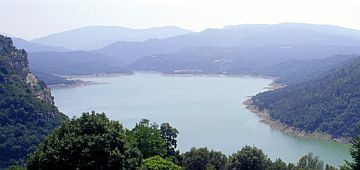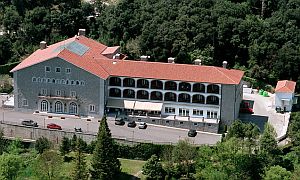
Vic-Sau, Catalonia, SpainVic has a very long history dating back to the Romans when it used to be called Ausa. In fact Iberian coins have been found in this area bearing its original name. In 788AD the city was more or less destroyed during an Arab invasion and only a quarter of it was rebuilt. However, the Count of Barcelona (known as 'Wilfred the Hairy') eventually re-conquered the city and tried to build it up again by encouraging others to come out there to settle. He took control of the higher end of town and built the Montcada Castle, and then gave the lower area to the Bishop of Vic who built the Cathedral you see today. There are many interesting historical buildings in Vic such as the Palau Episcopal, the Roman temple, the Convent of Sant Domenech, and of course the Cathedral which dominates the old quarter. The Cathedral's most impressive features are the crypt, the original bell tower, and the mural paintings by Josep Maria Sert. Next to it is the Episcopal Museum of Vic which is also worth a visit and has exhibits of Catalonia's Romanesque and Gothic art works. Like most Spanish towns, Vic has a very attractive Plaza Mayor and throughout the year it hosts several wonderful festivals, particularly in May and July. At the beginning of December they hold a Medieval Market as well, which is always great fun and creates a marvellous atmosphere leading up to Christmas.  Just outside Vic is a former Catalan farmhouse that has converted into superb accommodation. The Parador Hotel Vic-Sau not only has beautiful views of the Guillerias Mountains, but its facilities include a seasonal swimming pool, and an excellent restaurant serving the finest Catalan cuisine. It is a wonderful place to stay while you explore this part of Catalonia, and within easy reach of all the main attractions of this area.
Just outside Vic is a former Catalan farmhouse that has converted into superb accommodation. The Parador Hotel Vic-Sau not only has beautiful views of the Guillerias Mountains, but its facilities include a seasonal swimming pool, and an excellent restaurant serving the finest Catalan cuisine. It is a wonderful place to stay while you explore this part of Catalonia, and within easy reach of all the main attractions of this area.
For wine enthusiasts there is the highly recommended wine tastings at Celler d'en Jordi wineries. If you enjoy outdoor pursuits you can visit the dam at the Sau Reservoir, and explore the mountain trails either on foot, horseback, or on mountain bikes. The volcanic nature park of Garrotxa is also fairly close by. To the south is the city of Manresa with its beautiful basilica, the Santa Marķa y Santa Cova, and if you follow the Route of the Romanesque by car it will take you through some delightful villages such as Santa Maria del Corco and Rupit. Or visit the ancient Monasteries in the area such as the 11th century Monastery of Sant Pere de Casserres, Santa Maria de Ripoll, and the San Miquel del Fai Monastery. Only a few miles away is a dive centre called Diversub located on the Costa Brava that offers diving courses for all levels of experience. It is one of the most amazing dive sites in the Mediterranean Sea, and during the summer months you are guaranteed warm water and good visibility. There are of course many other water sports available along the coast, so if you are travelling with a family there is something for all ages to enjoy. |